Khakis
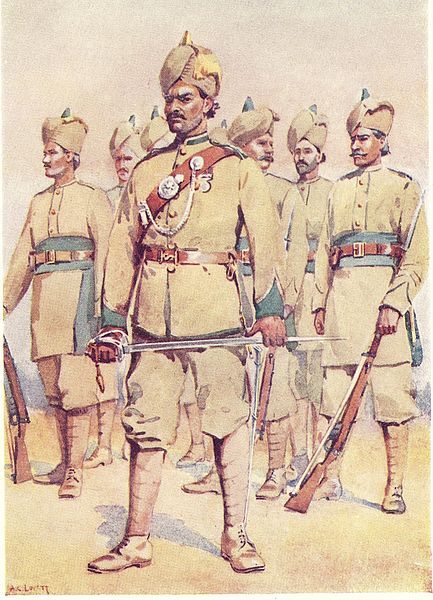
The
British Army's fancy scarlet tunic looked sharp, but was agonizingly
uncomfortable in the heat. The soldier's warm-weather option was a
dazzling white uniform -spiffy but impractical for daily use. How to
solve the problem?
JUST WILD ABOUT HARRY
Legend has it that a British colonial officer dabbled with the idea of creating his own lightweight, light-colored clothing to wear while he was stationed in India. What began as an off-duty ensemble evolved into military attire when it proved to be more comfortable and sensible than the existing uniform.
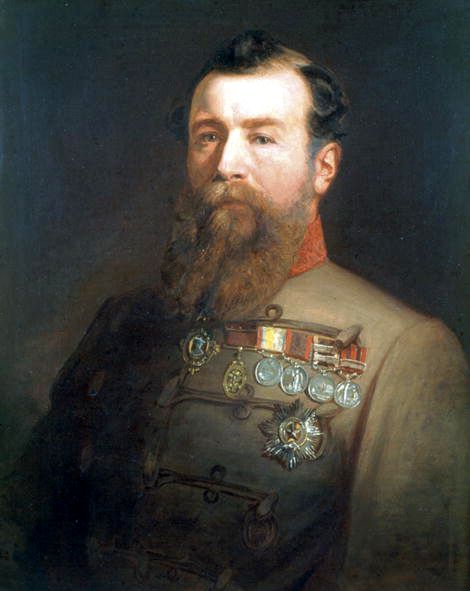 That
officer was Lieutenant Harry Lumsden, the son of a British colonal.
After schooling in England and Scotland, by age 17 Lumsden was serving
in the infantry in India. In 1846, when he was just 25, he was tapped for the duty that would lead to his greatest claim to fame.
That
officer was Lieutenant Harry Lumsden, the son of a British colonal.
After schooling in England and Scotland, by age 17 Lumsden was serving
in the infantry in India. In 1846, when he was just 25, he was tapped for the duty that would lead to his greatest claim to fame.Serving in Peshawar in what was then northwestern India (now Pakistan on the Afghanistan border), Lumsden was given the task of forming the Corps of Guides, a new regiment of infantry and cavalry soldiers. The 300 handpicked men were to serve as guides and scouts as well as fighting forces. Irregular cavalry regiments such as the Corps of Guides were allowed to wear what they wanted, within reason. Lumsden had an idea about what that should be. He'd been experimenting with loose-fitting cotton garments patterned after the local men's attire and dyed a muddy tan color, which hid the dirt and made the wearer less conspicuous in the dusty landscape of the battlefield. Locals dubbed the duds khaki, from the Hindi and Urdu word khak, meaning dust. Fellow British soldiers started calling the Corps of Guides the "mudlarks" because of the muddy color of their uniforms.
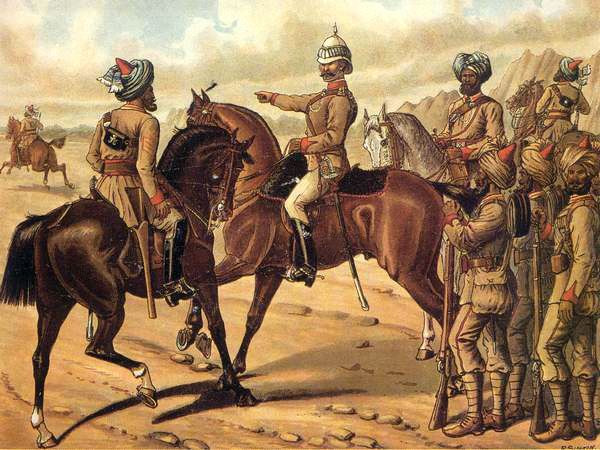
DUSTING OFF SOME FACTS ABOUT KHAKIS
Lumsden achieved that characteristic mud color by dunking the fabric in mud. In another version of the tale, he took his clothes to the local bazaar and had them colored with a dye made from the local mazari palm. When khaki caught on, Lumsden tried unsuccessfully to obtain drab uniform fabric from England. So he had the dying done locally, either by soldiers themselves or by civilians. While other regiments scoffed at the mudlarks initially, they soon adopted khaki as well, especially during the Indian Rebellion of 1857, which took place primarily during the summer months. Even then, the troops were left to color their own garments using mazari, coffee, tea, or even tobacco juice.
Fortunately, the rise of khaki uniforms coincided with the growth of the textile industry and the use of synthetic dyes. Khaki wasn't the first synthetic dye color developed in England -that distinction goes to aniline purple, better known as mauve, which was patented in 1856- but a patent for khaki dye was registered in England in 1884. It wasn't long before the British discovered it made more economic sense to import dye from Germany (which was leapfrogging ahead of other nations in the synthetic dye game). And that's where thing became awkward: By World War I, the British army was importing all the khaki dye for its uniforms from Germany, whom it happened to be fighting in the Great War. Color them embarrassed. (Before Americans start feeling smug, consider this: about 90 percent of the khaki dye used for U.S. uniforms in World War II was produced by the General Aniline and Film Corporation -better known as GAF- a German-owned company until the U.S. seized it in 1942.)
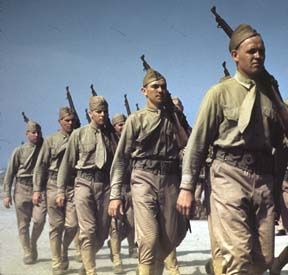 DRESS FOR SUCCESS
DRESS FOR SUCCESSThe U.S. military began wearing khaki during the Spanish-American War of 1898, but it didn't work for all purposes. In Guadalcanal's tropical jungles during World War II, khaki was deemed too conspicuous, so Army and Marine combat troops were issued green twill fatigues that blended better with their surroundings. The same was true for ground troops in the Vietnam War.
Of all the branches of the U.S. military, the Navy may have the closest association with khaki. It was first worn by Navy aviators in 1912, and a short time later, regulations required that ships carry enough khaki dye for "two suits of clothing for each man of the landing force," so the men could dye their "undress" white uniforms "when, in the opinion of the commanding officer, it is advisable to do so." (Generally, that would be when white uniforms would be dangerously obvious to the enemy, or when they became unduly soiled.) Khaki uniforms became standard issue for sumariners in 1931, but khaki is best known as naval officer's attire, so much so that the word "khaki" became a euphemism for "officer."
KHAKI COMES HOME
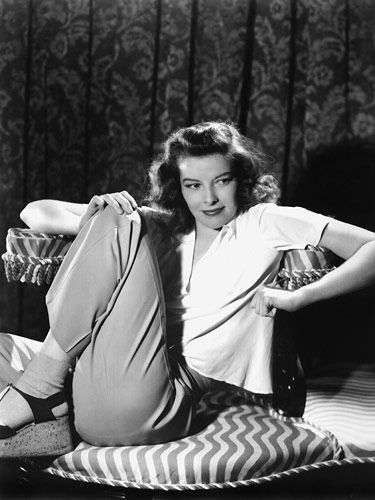 It
didn't take long for military-style khaki to become a fashion statement
on the home front. After the Second Boer War in South Africa, which
ended in 1902, shops in England began showing khaki clothing and
accessories for dapper Victorian gents, who liked its sportsmanlike,
heroic connotations. In America, the hard-wearing khaki that served U.S.
soldiers so well in World War I was adapted for Depression-era civilian
work clothing. In the 1940s, movie stars like Katherine Hepburn and
John Wayne wore khakis on-screen and off; in the 1950s, khakis were
standard issue for young American males, from the Leave It To Beaver boys to James Dean.
It
didn't take long for military-style khaki to become a fashion statement
on the home front. After the Second Boer War in South Africa, which
ended in 1902, shops in England began showing khaki clothing and
accessories for dapper Victorian gents, who liked its sportsmanlike,
heroic connotations. In America, the hard-wearing khaki that served U.S.
soldiers so well in World War I was adapted for Depression-era civilian
work clothing. In the 1940s, movie stars like Katherine Hepburn and
John Wayne wore khakis on-screen and off; in the 1950s, khakis were
standard issue for young American males, from the Leave It To Beaver boys to James Dean.In spite of changing fashion trends, khaki hung on in civilian life, with a reputation that ranged from conservative or square in the late 1960s and early 1970s, to preppy in the early 1980s, to fashionable in the mid-1980s, when the Levis Dockers brand was introduced and the rise of casual Fridays for office workers made khaki sales skyrocket.
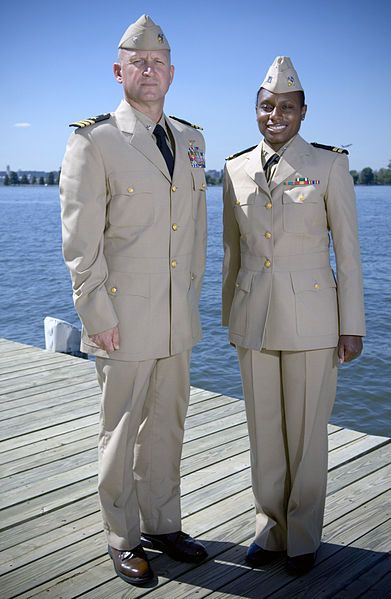 Meanwhile,
the miltary's endorsement of khaki continues. In July 2008, the U.S.
Navy introduced a new khaki dress uniform inspired by the dress khakis
worn from World War II through the Vietnam War, which officers may wear
in place of formal dress blues, dress whites, or service khakis. And a
new service uniform was introduced for enlisted personnel, with a khaki
shirt and black trousers. The idea, Navy spokepeople explain, is to
reduce the number of uniforms a sailor has to carry when deployed.
Whites are fine for the tropics, and dress blues work well for cooler
climates, but khaki goes with everything, everywhere -and that's the
point.
Meanwhile,
the miltary's endorsement of khaki continues. In July 2008, the U.S.
Navy introduced a new khaki dress uniform inspired by the dress khakis
worn from World War II through the Vietnam War, which officers may wear
in place of formal dress blues, dress whites, or service khakis. And a
new service uniform was introduced for enlisted personnel, with a khaki
shirt and black trousers. The idea, Navy spokepeople explain, is to
reduce the number of uniforms a sailor has to carry when deployed.
Whites are fine for the tropics, and dress blues work well for cooler
climates, but khaki goes with everything, everywhere -and that's the
point.

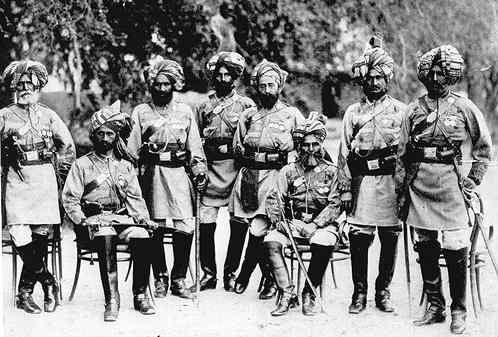
No comments:
Post a Comment